The Lineage-Defining Transcription Factors SOX2 and NKX2-1 Determine Lung Cancer Cell Fate and Shape the Tumor Immune Microenvironment
- PMID: 30332632
- PMCID: PMC6197489
- DOI: 10.1016/j.immuni.2018.09.020
The Lineage-Defining Transcription Factors SOX2 and NKX2-1 Determine Lung Cancer Cell Fate and Shape the Tumor Immune Microenvironment
Abstract
The major types of non-small-cell lung cancer (NSCLC)-squamous cell carcinoma and adenocarcinoma-have distinct immune microenvironments. We developed a genetic model of squamous NSCLC on the basis of overexpression of the transcription factor Sox2, which specifies lung basal cell fate, and loss of the tumor suppressor Lkb1 (SL mice). SL tumors recapitulated gene-expression and immune-infiltrate features of human squamous NSCLC; such features included enrichment of tumor-associated neutrophils (TANs) and decreased expression of NKX2-1, a transcriptional regulator that specifies alveolar cell fate. In Kras-driven adenocarcinomas, mis-expression of Sox2 or loss of Nkx2-1 led to TAN recruitment. TAN recruitment involved SOX2-mediated production of the chemokine CXCL5. Deletion of Nkx2-1 in SL mice (SNL) revealed that NKX2-1 suppresses SOX2-driven squamous tumorigenesis by repressing adeno-to-squamous transdifferentiation. Depletion of TANs in SNL mice reduced squamous tumors, suggesting that TANs foster squamous cell fate. Thus, lineage-defining transcription factors determine the tumor immune microenvironment, which in turn might impact the nature of the tumor.
Keywords: CXCL5; NKX2-1; SOX2; adenocarcinoma; lung cancer; mouse models; squamous; transdifferentiation; tumor immune microenvironment; tumor-associated neutrophils.
Copyright © 2018 Elsevier Inc. All rights reserved.
Conflict of interest statement
DECLARATION OF INTERESTS
The authors have no competing interests.
Figures


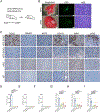
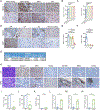
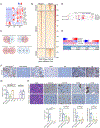
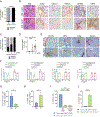
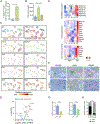
Comment in
-
Lineage Specifiers in Lung Cancer Are Ahead of Their TIME.Immunity. 2018 Oct 16;49(4):587-589. doi: 10.1016/j.immuni.2018.10.004. Immunity. 2018. PMID: 30332625
Similar articles
-
Developmental History Provides a Roadmap for the Emergence of Tumor Plasticity.Dev Cell. 2018 Mar 26;44(6):679-693.e5. doi: 10.1016/j.devcel.2018.02.024. Dev Cell. 2018. PMID: 29587142 Free PMC article.
-
Tumor suppressors in Sox2-mediated lung cancers promote distinct cell-intrinsic and immunologic remodeling.JCI Insight. 2025 May 6;10(12):e171364. doi: 10.1172/jci.insight.171364. eCollection 2025 Jun 23. JCI Insight. 2025. PMID: 40327401 Free PMC article.
-
Neutrophils Recruited by NKX2-1 Suppression via Activation of CXCLs/CXCR2 Axis Promote Lung Adenocarcinoma Progression.Adv Sci (Weinh). 2024 Oct;11(38):e2400370. doi: 10.1002/advs.202400370. Epub 2024 Aug 7. Adv Sci (Weinh). 2024. PMID: 39113226 Free PMC article.
-
SOX2 and squamous cancers.Semin Cancer Biol. 2020 Dec;67(Pt 1):154-167. doi: 10.1016/j.semcancer.2020.05.007. Epub 2020 Sep 6. Semin Cancer Biol. 2020. PMID: 32905832 Review.
-
[Research Progress of Tumor-associated Neutrophils in the Occurrence and Development of Lung Cancer].Zhongguo Fei Ai Za Zhi. 2025 Jan 20;28(1):55-62. doi: 10.3779/j.issn.1009-3419.2025.101.02. Zhongguo Fei Ai Za Zhi. 2025. PMID: 39988440 Free PMC article. Review. Chinese.
Cited by
-
Histologic transformation in lung cancer: when one door shuts, another opens.Ther Adv Med Oncol. 2022 Oct 14;14:17588359221130503. doi: 10.1177/17588359221130503. eCollection 2022. Ther Adv Med Oncol. 2022. PMID: 36268218 Free PMC article. Review.
-
KMT2D deficiency drives lung squamous cell carcinoma and hypersensitivity to RTK-RAS inhibition.Cancer Cell. 2023 Jan 9;41(1):88-105.e8. doi: 10.1016/j.ccell.2022.11.015. Epub 2022 Dec 15. Cancer Cell. 2023. PMID: 36525973 Free PMC article.
-
FoxA1 and FoxA2 control growth and cellular identity in NKX2-1-positive lung adenocarcinoma.Dev Cell. 2022 Aug 8;57(15):1866-1882.e10. doi: 10.1016/j.devcel.2022.06.017. Epub 2022 Jul 13. Dev Cell. 2022. PMID: 35835117 Free PMC article.
-
Immune Escape Mechanisms in Non Small Cell Lung Cancer.Cancers (Basel). 2020 Dec 2;12(12):3605. doi: 10.3390/cancers12123605. Cancers (Basel). 2020. PMID: 33276569 Free PMC article. Review.
-
The role of autoantibody detection in the diagnosis and staging of lung cancer.Ann Transl Med. 2021 Nov;9(22):1673. doi: 10.21037/atm-21-5357. Ann Transl Med. 2021. PMID: 34988182 Free PMC article.
References
-
- Bezzi M, Seitzer N, Ishikawa T, Reschke M, Chen M, Wang G, Mitchell C, Ng C, Katon J, Lunardi A, et al. (2018). Diverse genetic-driven immune landscapes dictate tumor progression through distinct mechanisms. Nat. Med 24, 165–175. - PubMed
-
- Campbell EL, Bruyninckx WJ, Kelly CJ, Glover LE, McNamee EN, Bowers BE, Bayless AJ, Scully M, Saeedi BJ, Golden-Mason L, et al. (2014). Transmigrating neutrophils shape the mucosal microenvironment through localized oxygen depletion to influence resolution of inflammation. Immunity 40, 66–77. - PMC - PubMed
Publication types
MeSH terms
Substances
Grants and funding
LinkOut - more resources
Full Text Sources
Other Literature Sources
Molecular Biology Databases
Research Materials
Miscellaneous

